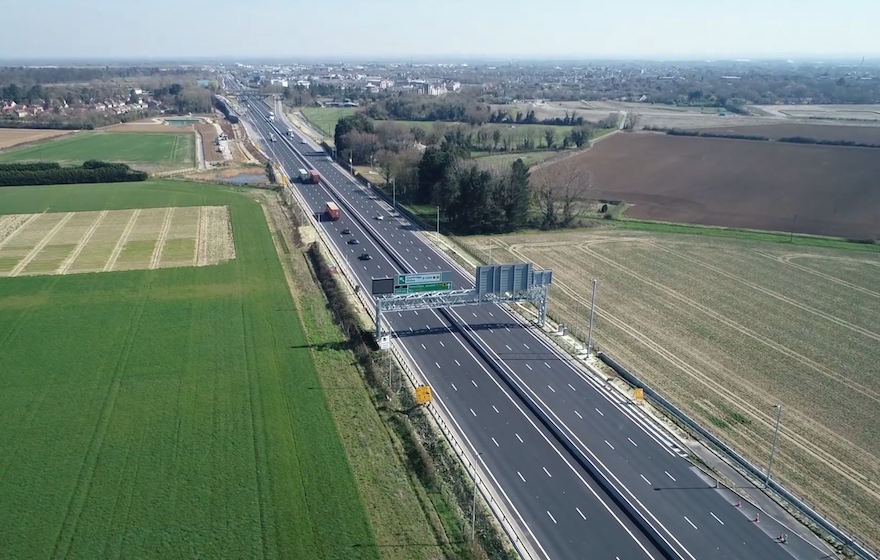Increased digital design and construction, smart equipment and plant, digital twins and a digital leaders forum are among the key elements of Highways England’s (HE) new digital strategy.
The three overall objectives of the strategy are:
- Transform services across asset management, operations, customer-focused and corporate functions.
- Enable HE staff by providing them with the data they need to make better decisions and the technology they need to do their job safely and securely.
- Improve the delivery of digital, data and technology services by adopting more efficient, flexible and streamlined approaches as well as using cutting edge techniques.
Victoria Higgin, chief information officer and executive director of information technology at HE, said: “We will strive to become thought leaders in the digital, data and technology services we provide. We can only transform, enable and improve through a relentless focus on growing in-house digital, data and technology capabilities. We will need expertise and knowledge in critical technical areas, as well as building strong and mutually beneficial partnerships with an expert supply chain.”
The strategy document reveals more detailed commitments, for example HE will “digitise and automate design, and integrate connected construction activities such as estimation, sequencing and costing”.
HE will also reduce “plant/site operative conflicts through increased use of connected and semi-automated plant for construction and make greater use of data science for elements such as predictive maintenance”.
The increased use of digital twins will “improve the design and test the strength of the strategic road network for road-users and operators”.
HE plans to establish a digital leaders forum that will build a chief information officer network for the roads construction industry to increase transparency and collaboration.
The strategy document provides for the future of autonomous transport: “We must consider how our customer will evolve. While today most of our customers are humans informed by data and technology, the increasing amount of connected and autonomous vehicle technology used in private and commercial vehicles could mean a future of providing data to self-driving systems. We must understand this direction and be prepared.”
Indeed, HE plans to do more than keep abreast of technological change: “The world is changing at pace. To keep on top of that change, we will invest in a digital lab that focuses on working with the brightest minds to create fast paced innovative solutions using innovative tools and techniques.”

The use of AI on the A14 Cambridge to Huntingdon improvement scheme ensured a safer construction phase
AI ensures safer construction: the A14
In launching the strategy, HE cited the success of the A14 Cambridge to Huntingdon improvement scheme that opened a year ago.
Since work started on the scheme in November 2016, the A14 integrated team of companies and contractors working on the project looked to create a uniform way of collecting data, including launching an A14 app which staff could use to record both hazards and good practice. At its peak, some 4,500 observations were submitted in one month.
With so much data available, from health and safety observations to information about vehicle movements and commercial activity, an advanced AI was used for the first time on a roads project. The £70,000 initiative generated a daily risk profile based on the data it had collected, identifying which days were higher risk and why.
The model was built using these profiles as an indicator for risk, with its findings complemented by the project’s incident register, planned activities, working patterns, job roles, and external factors such as the weather. The development team explored the findings to look into what separated days with ‘harmful features’ from those without them, developing 135 of these ‘features’ that the model could then explore and prioritise, based on their likelihood, including:
- working past 6pm;
- working more than nine hours;
- working in high winds;
- ratio of shift time for archaeologists to that of supervisors
- working following heavy rainfall, and;
- working immediately after a bank holiday or national sporting event.
Looking to identify these high-risk days, the AI was used as a pilot with 75% success: “a remarkable result,” according to HE. An unexpected outcome was the discovery that a workforce engaged in reporting hazards results in less harm. Therefore, as the project progressed and incidents of harm were reduced, the accuracy of the model reduced to 65% as there was less data for it to analyse. Despite that, it still proved 160% more accurate than merely guessing which days were likely to have an increased risk.
The AI identified that one of the most prominent themes affecting risk days was staff fatigue, allowing practical measures (such as ensuring breaks are taken) to be implemented to improve safety.
The findings of the AI will now be used on other HE projects and should make sites safer for road workers, while also improving efficiency.
David Bray, HE project director for the A14, said: “HE has adopted the A14’s approach and technologies for its own digital platform, which is being rolled out across our portfolio. We believe this technology will deliver significant cost savings as paper-based reporting is replaced by real-time data, consistently captured and accessible to our project managers.”
Mark Tootell, HE head of the A14 project management office who led the project, said: “This exciting research demonstrates three important principles that projects should adopt: the importance of fostering a healthy observation reporting culture across the entire workforce; the value in taking a variety of factors into account; and the need for well organised, broad and honest data sets.”
Jaydip Jani, A14 data analyst, added: “The AI health and safety project showed incredible promise and will only improve as more, better quality data is available. It has shown the industry the intrinsic value in well-gathered data and the potential for truly data-guided decision making.”
Read HE’s digital strategy: https://highwaysengland.co.uk/industry/digital-data-and-technology-strategy/
Main image: 198879478 © Ded Mityay | Dreamstime.com













